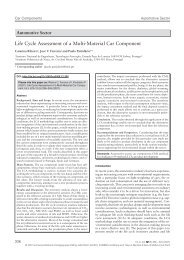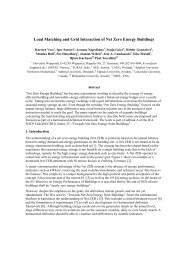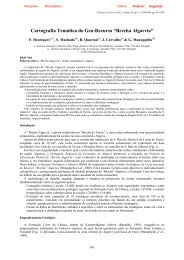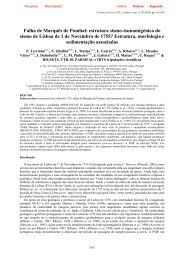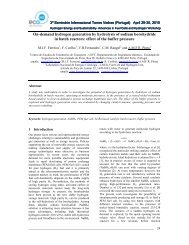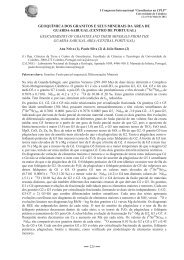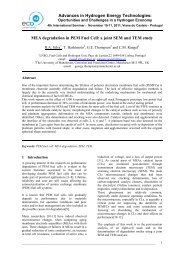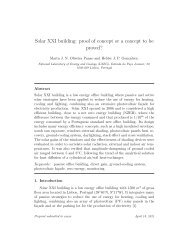1 IN-SITU REMOVAL OF ARSENIC FROM GROUNDWATER USING ...
1 IN-SITU REMOVAL OF ARSENIC FROM GROUNDWATER USING ...
1 IN-SITU REMOVAL OF ARSENIC FROM GROUNDWATER USING ...
- No tags were found...
Create successful ePaper yourself
Turn your PDF publications into a flip-book with our unique Google optimized e-Paper software.
ConclusionsThis research proves that IBS may be used as reactive media in PRB. The two commercialsorbents tested, ARM 300 and GEH 102, remove efficiently both As(III), As(V) and theirmixtures. As(V) is removed easier than As(III). Breakthrough curves obtained in differentoperating conditions allowed comparing both sorbents: the loading capacity is similar, around20 g of As/ kg, and GEH has a slightly more favourable performance. Particles of the sorbents,after subjected to adsorption tests in fixed bed columns during 30 days, were subjected toanalysis using an electron microprobe analyzer. Spatial mapping of the concentrations allowsinfer that the removal mechanisms are different: while for ARM 300 reductive precipitation isrelevant for GEH 102 the adsorption mechanisms with complex formation are prevalent.AcknowledgementsThe authors would like to thank The National Foundation for Science and Technology(Fundacão para a Ciência e Tecnologia FCT) for the financial support of this research that ispart of the project. PTDC/ECM/70216.REFERENCESBaker M.J., Blowes D.W., Ptacek C.J., 1998, Laboratory development of permeable reactivemixtures for the removal of phosphorous from onsite wastewater disposal systems, Environ. Sci.Technol. 32, 2308–2316 .Bang S., Korfiatis G. P., Meng , 2005 , Removal of arsenic from water by zero-valent iron,Journal of Hazardous Materials 121, 61–67.Beak. D. G., Wilkin R.T.,2009, Performance of a zerovalent iron reactive barrier for thetreatment of arsenic in groundwater: Part 2 Geochemical modeling and solid phase studies,Journal of Contaminant Hydrology, 106, 15–28.Cortina J-L., Fiúza A., Silva A., Litter M, 2010, Tecnologías de tratamiento in-situ de aguassubterrâneas, Chapter seven of “Tecnologías Económicas Para El Abatimiento de Arsénico enAguas”, Project Cyted, Edited by Marta I. Litter, Ana María Sancha, Ana María Ingallinella.Driehaus, W., Jekel, M. and Hildebrandt, U., 1998, Granular ferric hydroxide – a new adsorbentfor the removal of arsenic from natural water, Blackwell Science Ltd. J. Water SRT- Aqua 47, 30–35Farrel J., Melitas N., Conklin M., O’Day P., 2001, Understanding Arsenic Removal Mechanismsin Iron Media Filters, International Conference “Arsenic in Drinking Water”, New York.Ferreira M. A., Barros A., A, 2002, Determination of As(III) and arsenic(V) in natural watersby cathodic stripping voltammetry at a hanging mercury drop electrode, Analytica ChimicaActa 459, 151–159.Gibert O, Pablo J, Cortina J-L., Ayora C., 2010, In situ removal of arsenic from groundwater byusing permeable reactive barriers of organic matter/limestone/ zero-valent iron mixtures EnvironGeochem Health, 32:373–378Ipsen S-O., Gerth J., Förstner U., 2005, Identifying and testing materials for arsenic removal bypermeable reactive barriers, Consoil 2005, 1815-1817.13




